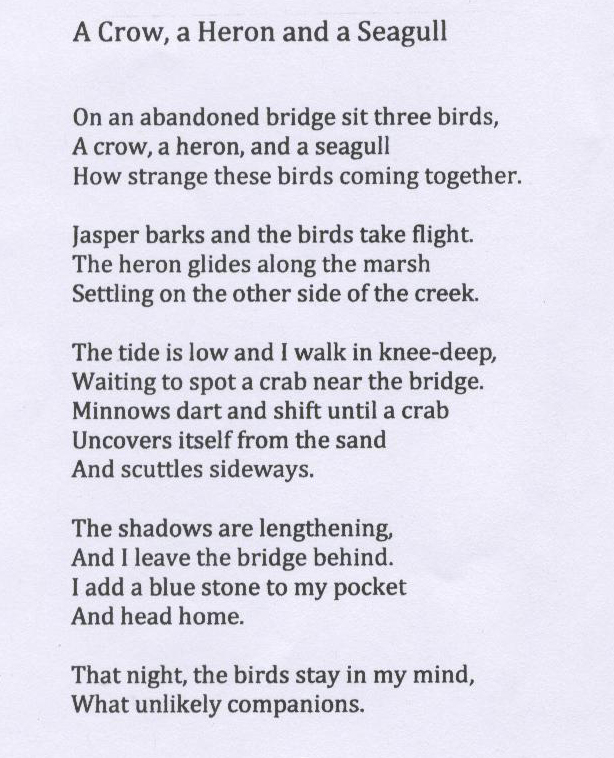2013
SARAH MOOK
POETRY PRIZE RESULTS
3-5 SECOND PLACE
Henry
Prantis
East Sandwich, MA
 |
|
COMMENTS FROM CONTEST JUDGE MARIE KANE: This understated poem asserts itself with an unusual topic choice, vivid details, and expert language. It describes a small moment in time (as many good poems do) with surety and resonant details that easily place the reader in the setting. Purposeful line breaks and exact word choice also mark this poem as a winner. The first stanza of the poem gives the setting. The three birds in the title "sit on an abandoned bridge," a distinct visual detail. The author then repeats the names of the birds, "A crow, a heron, and a seagull," as if to emphasize the oddity of their being together. In fact, the last line of the first stanza then states "How strange these birds coming together." The second stanza effectively moves the action of the poem. The speaker tells us:
I appreciate that the dog, Jasper, is introduced by his "bark." In response, the birds "take flight" and the heron's movement is singled out as it "glides," "settling on the other side of the creek." These brief images captivate the reader. The longest section, the third, moves back to the speaker and the surrounding environment. The specific details, again, are captivating. We are told that the "tide is low" and that the speaker "walk[s] in knee-deep / Waiting to spot a crab near the bridge" / as "minnows dart and shift." The precise word choice and the specific verbs of "spot" and "dart and shift" bring the scene into focus. At the end of the section, "a crab / uncovers itself from the sand / And scuttles sideways." Describing the crab as something that "uncovers itself" and "scuttles" shows a refreshing use of language. I also like that the bridge is referenced again in the poem. The scene is expertly drawn without extravagant detail and emotion. Also, the alliteration with "scuttles sideways" is pleasing. It is in the fourth section that the speaker more deftly uses detail to suggest action and the passage of time. The peaceful tone is clear:
One can appreciate the "lengthening shadows" and understand their signal to "leave the bridge behind." Again, the bridge is a needed focal point to tie the poem together. The "blue stone" that the speaker "adds" to "my pocket" intrigues by suggesting that other things have been pocketed as well. Do we need to know these things? No, and that is where this poet shines. To say only that a "blue stone" (wonderful choice of "blue") has been added to the speaker's pocket collection is perfect for the understated nature of this poem. The couplet at the end of the poem jumps ahead in time to "that night" where the "birds stay in my mind, / What unlikely companions." It is the adjective "unlikely" and the noun "companions" that surprise. As the poem notes in the opening, "A crow, a heron, and a seagull" are "strange" when taken together, yet that night they are the speaker's "unlikely companions." They have made a lasting impression on the speaker and the reader as well. This refreshing
poem reflects on a brief period of time and specific place with precision.
This poet uses expressive detail to create lasting images. Thank you for the privilege of reading your work! Marie
Kane |